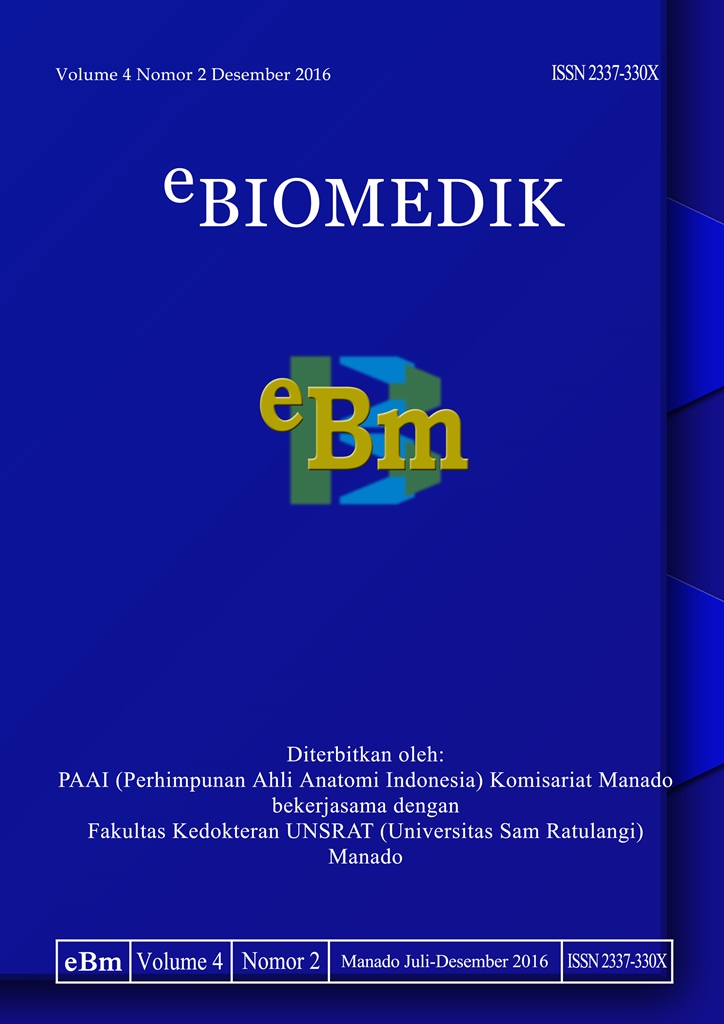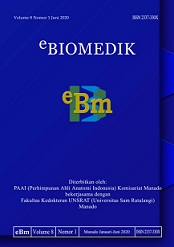Perubahan histologik pada usus besar hewan coba postmortem
DOI:
https://doi.org/10.35790/ebm.v4i2.14768Abstract
Abstract: Cell death occurs after somatic death. The aerobic process of cells would be halted as a result of somatic death, whereas the anaerobic process will continue. Therefore, the cells do not die in a short time although the oxygen supply has been depleted. This anaerobic process will have an impact on the morphology and activity of cells. This study was aimed to obtain the microscopic changes of large intestine for 24 hours postmortem. This was a descriptive observational study. A domestic pig weighed 20 kg was used as sample. The microscopic examinations were performed at several interval times as follow: 0, 1, 2, 3, 4, 5, 6, 7, 8, 9, 12, 14, 16, 18, 20, 22, and 24 hours postmortem. The results showed that the microscopic changes of the large intestine were identified the earliest at 2 hours postmortem as congestion with dilatation of the intestinal crypt lumen; lysis of a number of intestinal crypts at 6 hours postmortem; all intestinal crypts were lysis leaving empty areas; and the mucosal layer and intestinal crypts could not be identified at 24 hours postmortem. Conclusion: The earliest microscopic changes of the large intestine occured at 2 hours postmortem. Lysis of the intestinal crypts began at 6 hours postmortem and became complete at 12 hours postmortem.
Keywords: large intestine, postmortem, intestinal crypt
Â
Abstrak: Kematian sel terjadi setelah kematian somatis. Proses aerobik sel-sel akan terhenti akibat kematian somatis, sedangkan proses anaerobik akan tetap berlangsung. Hal tersebut mengakibatkan sel-sel tidak mati dalam waktu yang singkat meskipun pasokan oksigen telah habis. Proses anaerobik ini akan berdampak pada morfologi dan aktivitas sel. Penelitian ini bertujuan untuk mendapatkan perubahan gambaran histologik usus besar pada hewan coba selama 24 jam postmortem. Jenis penelitian ialah deskriptif observasional. Sampel penelitian ialah satu ekor babi domestik dengan berat 20 kg. Pengamatan mikroskopik terhadap sampel dilakukan pada beberapa interval waktu, yaitu: 0 jam, 1 jam, 2 jam, 3 jam, 4 jam, 5 jam, 6 jam, 7 jam, 8 jam, 9 jam, 12 jam, 14, 16 jam, 18 jam, 20 jam, 22 jam, dan 24 jam postmortem. Hasil penelitian mendapatkan perubahan mikroskopik postmortem paling awal pada usus besar terjadi pada 2 jam postmortem berupa kongesti dengan lumen kripta Lieberkuhn yang berdilatasi; pada 6 jam postmortem tampak sebagian kripta Lieberkuhn telah lisis; pada 12 jam postmortem seluruh kripta Lieberkuhn telah lisis; dan pada 24 jam postmortem lapisan epitel dan kripta Lieberkuhn tidak dapat diidentifikasi lagi. Simpulan: Perubahan histologik postmortem paling awal pada 3 jam postmortem, lisis kripta Lieberkuhn telah tampak sejak 6 jam postmortem, dan menyeluruh pada 12 jam postmortem.
Kata kunci: usus besar, postmortem, kripta Lieberkuhn





